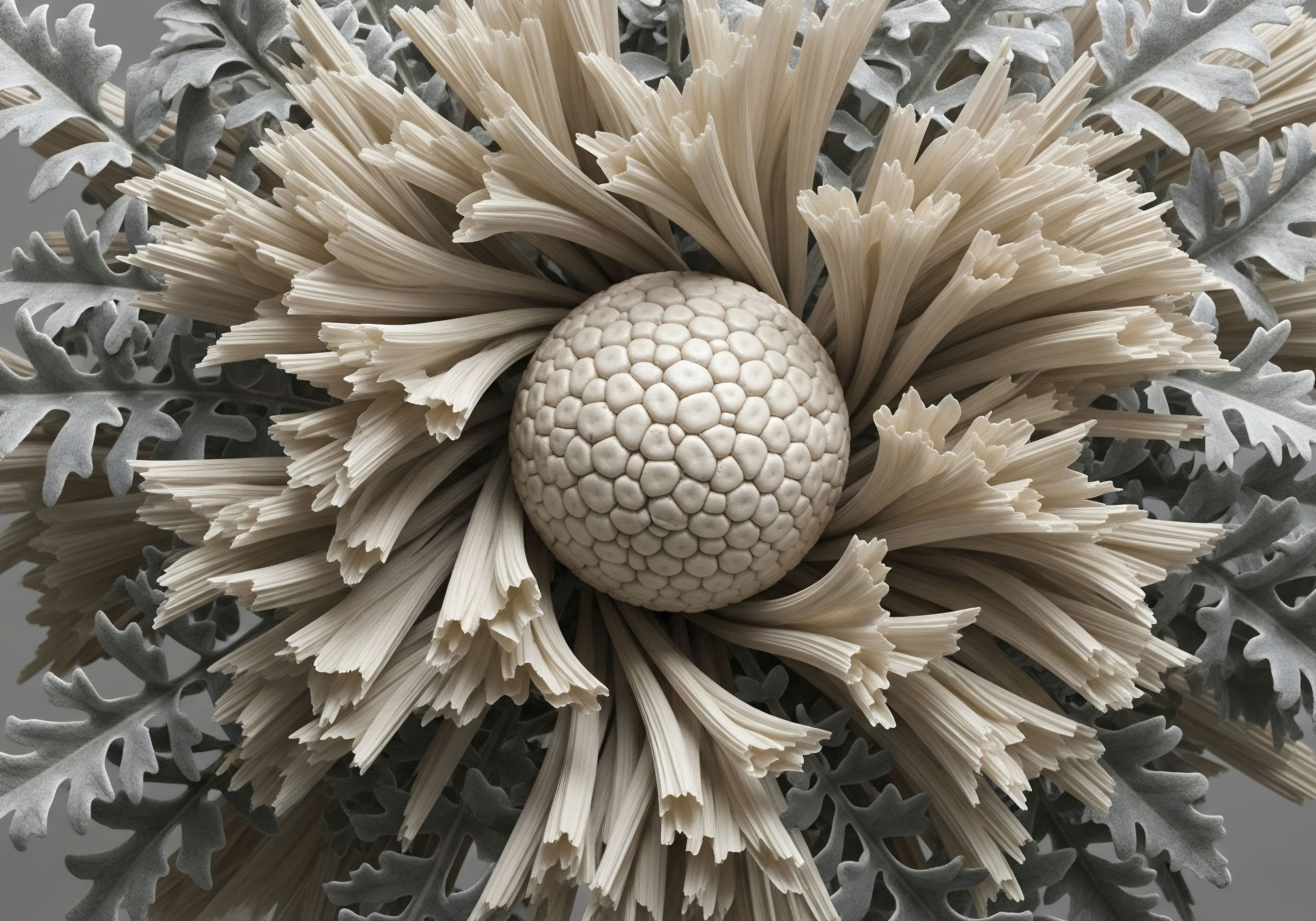

Fundamentals
The feeling often arrives subtly. It can manifest as a persistent mental fog that clouds focus, a physical weariness that defies a full night’s sleep, or a noticeable decline in drive and vitality. These experiences are not abstract complaints; they are tangible signals from your body’s intricate communication network.
This network, the endocrine system, relies on chemical messengers called hormones to regulate countless functions, from energy metabolism to mood. When a key messenger like testosterone becomes deficient, the entire system can lose its coherence, leading to symptoms that profoundly affect your quality of life. The process of determining the correct testosterone dosage is a clinical partnership aimed at restoring that coherence.
Understanding this process begins with appreciating that your body does not use testosterone in a single form. When a blood sample is analyzed, it reveals a complex picture. The most common measurement is total testosterone, which accounts for every testosterone molecule in the sample.
However, a large portion of this total amount is tightly bound to a protein called Sex Hormone-Binding Globulin (SHBG). Testosterone attached to SHBG is biologically inactive, acting as a reservoir that is unavailable for immediate use by your cells. Another portion is weakly attached to a different protein, albumin.
The remaining fraction, typically only 1-3% of the total, is unbound and known as free testosterone. This is the hormone that can freely enter cells and exert its effects. Clinicians look at the interplay between these values to understand your unique hormonal landscape.

The Body’s Internal Thermostat
Your body’s natural production of testosterone is governed by a sophisticated feedback system known as the Hypothalamic-Pituitary-Gonadal (HPG) axis. Think of it as a highly calibrated internal thermostat. The hypothalamus in your brain monitors circulating hormone levels. When it detects a need for more testosterone, it releases Gonadotropin-Releasing Hormone (GnRH).
This signals the pituitary gland to secrete Luteinizing Hormone (LH) and Follicle-Stimulating Hormone (FSH). LH then travels to the testicles, instructing them to produce and release testosterone. As testosterone levels in the blood rise to an optimal point, the hypothalamus reduces its GnRH signal, slowing the entire process down.
A diagnosis of hypogonadism, or clinically low testosterone, indicates a disruption somewhere in this axis. The goal of hormonal optimization is to support this system, providing what is missing to re-establish stable and effective signaling.
The initial diagnostic process validates a patient’s symptoms with objective biochemical data, forming the foundation for a therapeutic plan.
The first step in any clinical protocol is a comprehensive diagnostic workup. This involves more than a single blood test. According to guidelines from organizations like The Endocrine Society, a diagnosis requires both consistent symptoms and unequivocally low testosterone concentrations, typically confirmed with at least two separate morning blood tests.
The morning is specified because testosterone levels naturally follow a diurnal rhythm, peaking in the early hours. A clinician will evaluate your total testosterone, but may also specifically measure free or bioavailable testosterone, especially if your SHBG levels are suspected to be abnormal due to factors like age or other health conditions. This detailed initial assessment ensures that the therapy is appropriate and tailored to the specific nature of the hormonal disruption.

Defining the Therapeutic Window
Once a diagnosis is confirmed, the process of determining dosage begins. The objective is to administer testosterone to reach a concentration in the blood that falls within the mid-normal range for healthy young men. This is a therapeutic target, not a single number.
The “optimal” dose is the amount required for an individual to achieve symptom resolution while maintaining safety and avoiding adverse effects. It is a process of careful calibration, starting with a standard dose and adjusting based on follow-up lab work and patient feedback. This methodical approach acknowledges that each person’s physiology is unique.
Factors like body composition, metabolic rate, and individual sensitivity to hormones all influence how a person will respond to a given dose. The journey to an optimal dose is a dynamic one, guided by both objective data and your subjective experience of well-being.


Intermediate
Moving from diagnosis to active management involves a detailed examination of the clinical tools used to restore hormonal function. The primary agent in many protocols is Testosterone Cypionate, an injectable form of testosterone. It is an esterified version of the hormone, meaning it is chemically modified to be absorbed slowly from an oil-based solution injected into the muscle.
This modification is critical for practical use; unmodified testosterone has a half-life of only about 10 minutes, which would require impossibly frequent dosing. The cypionate ester allows for a much slower release, with a half-life of approximately eight days, enabling a more manageable dosing schedule, typically once a week.
A standard starting protocol might involve a weekly intramuscular injection of 100-200mg of Testosterone Cypionate. The clinical objective is to create stable blood serum concentrations that alleviate the symptoms of hypogonadism without creating extreme peaks and troughs.
Pharmacokinetic studies show that a 200mg injection of testosterone cypionate causes serum levels to peak several days after administration, often reaching supraphysiologic (higher than normal) levels, before gradually declining over the following week. More frequent, smaller injections (e.g.
twice weekly) can mitigate these fluctuations, leading to more stable serum levels and a more consistent sense of well-being for many individuals. The choice of dosing frequency is a key variable that is adjusted based on patient response and follow-up lab results.

How Do Ancillary Medications Support the Primary Protocol?
A comprehensive hormonal optimization strategy often includes ancillary medications designed to manage the body’s response to exogenous testosterone. Introducing testosterone from an external source suppresses the HPG axis, meaning the brain reduces its LH and FSH signals. This shutdown can lead to testicular atrophy and a cessation of the body’s own testosterone and sperm production.
To counteract this, clinicians may prescribe Gonadorelin. Gonadorelin is a synthetic form of GnRH, the hormone released by the hypothalamus. By administering it, typically via subcutaneous injection two or more times per week, the protocol directly stimulates the pituitary gland to continue releasing LH and FSH. This preserves testicular function, size, and fertility, effectively keeping the natural production pathway active while on therapy.
Another critical consideration is the management of estrogen. An enzyme called aromatase, present in various body tissues, converts a portion of testosterone into estradiol, a form of estrogen. While men require a certain amount of estradiol for functions like bone health and cognitive function, elevated levels can cause unwanted side effects, including water retention and gynecomastia (the development of breast tissue).
To manage this conversion, an aromatase inhibitor like Anastrozole may be included in the protocol. Anastrozole blocks the aromatase enzyme, thereby reducing the amount of testosterone that gets converted to estradiol. The use and dosage of Anastrozole are carefully managed, as excessively suppressing estrogen can lead to its own set of negative consequences, such as joint pain and decreased libido. The goal is to maintain a healthy testosterone-to-estrogen ratio.
Effective dosing is a multi-variable equation, balancing the primary hormone with supportive agents to maintain systemic equilibrium.
The table below outlines a typical starting protocol and the function of each component, illustrating how they work together to create a balanced physiological environment.
| Medication | Typical Starting Protocol | Primary Clinical Purpose |
|---|---|---|
| Testosterone Cypionate | 100-200 mg per week (intramuscular) | Primary androgen replacement to restore serum testosterone to optimal levels and resolve symptoms of hypogonadism. |
| Gonadorelin | 25-50 units (0.25-0.5mg) 2x per week (subcutaneous) | Stimulates the pituitary to release LH and FSH, preserving testicular function, size, and fertility during therapy. |
| Anastrozole | 0.25-0.5 mg 2x per week (oral) | Inhibits the aromatase enzyme, controlling the conversion of testosterone to estradiol to prevent estrogen-related side effects. |
| Enclomiphene | 12.5-25 mg per day (oral) | May be used to selectively block estrogen receptors at the hypothalamus, increasing LH and FSH production to support natural testosterone. |

Monitoring and Titration the Path to Optimization
The initial protocol is a starting point. The process of finding an individual’s optimal dose is iterative and data-driven. Follow-up blood tests are typically performed several weeks after initiating or adjusting therapy. The timing of the blood draw is crucial.
For weekly injections, blood is often drawn at the “trough,” or the point just before the next scheduled injection, to see the lowest level the hormone reaches. The Endocrine Society guidelines suggest aiming for a total testosterone level in the mid-normal range during therapy.
Based on these results and the patient’s subjective feedback on symptoms, the clinician will titrate the dose. This could mean adjusting the amount of testosterone, the frequency of injections, or the dosage of ancillary medications like Anastrozole. This continuous loop of treatment, monitoring, and adjustment is the core of personalized hormonal medicine.


Academic
A sophisticated approach to testosterone dosing extends beyond simply targeting a specific serum concentration. It involves a deep appreciation for the complex interplay between the endocrine system and broader metabolic health. Testosterone does not function in isolation; it is a powerful metabolic regulator, and its administration initiates a cascade of biochemical changes that influence insulin sensitivity, lipid metabolism, and inflammatory pathways.
The academic challenge in dosing is to optimize this entire system, not just a single biomarker. The choice of dosage and protocol structure can have divergent effects on these interconnected systems, necessitating a highly individualized and evidence-based strategy.
The foundation of this systemic view lies in understanding the transport and bioavailability of testosterone. Over 97% of circulating testosterone is bound to proteins, primarily SHBG and, to a lesser extent, albumin. The affinity of testosterone for SHBG is very high, rendering SHBG-bound testosterone biologically inert.
Albumin-bound testosterone is held more weakly and is considered bioavailable. The small unbound fraction is free testosterone. Clinical conditions like obesity, type 2 diabetes, and aging are often associated with lower SHBG levels. In such cases, a total testosterone reading may appear low, but the free testosterone fraction might be relatively normal.
Conversely, high SHBG can artificially inflate total testosterone while masking a functional deficiency of free testosterone. Therefore, an academic approach to dosing relies on calculating free or bioavailable testosterone, using validated formulas or equilibrium dialysis, to get a more accurate picture of the physiologically active hormone pool. This prevents both under- and over-treatment based on a potentially misleading total testosterone value.

What Are the Limitations of Standard Laboratory Reference Ranges?
Standard laboratory reference ranges for testosterone are typically derived from statistical analysis of a broad population. These ranges present a significant clinical limitation because they often fail to account for age-related decline and individual physiological differences. A “normal” range might span from 300 ng/dL to 1000 ng/dL.
For a 60-year-old man, a level of 350 ng/dL would be classified as “normal,” yet it represents a value that would be considered low for a healthy 25-year-old and may be insufficient to prevent symptoms.
The Endocrine Society guidelines acknowledge this by recommending that clinicians aim for the mid-normal range when treating hypogonadism, implicitly recognizing that the lower end of the range may not be optimal for symptom resolution. True optimization requires interpreting lab values in the context of the individual’s symptoms, age, and metabolic health, rather than adhering rigidly to a broad statistical norm.

Pharmacokinetics and Metabolic Impact
The delivery method and dosing frequency of testosterone profoundly influence its metabolic effects. A single, large intramuscular injection of Testosterone Cypionate every two weeks creates a significant peak-and-trough pattern. The initial supraphysiologic peak can lead to a temporary spike in aromatization, increasing estradiol levels and potentially requiring more aggressive management with an aromatase inhibitor.
This fluctuation can also impact mood and energy levels. In contrast, more frequent subcutaneous or intramuscular injections (e.g. twice weekly) of a smaller dose produce far more stable serum testosterone and estradiol levels. This stability can lead to better metabolic outcomes. Research indicates that stable, physiologic testosterone levels improve insulin sensitivity, promote favorable changes in body composition (increased lean mass, decreased fat mass), and can have beneficial effects on lipid profiles.
The ultimate goal of academic dosing is to replicate a stable, youthful hormonal milieu to optimize metabolic function and mitigate long-term health risks.
The following table summarizes findings from various clinical studies on the metabolic impact of testosterone therapy, highlighting the systemic effects of hormonal optimization.
| Metabolic Parameter | Observed Effect of Testosterone Therapy | Underlying Mechanism |
|---|---|---|
| Insulin Sensitivity | Improved, particularly in men with type 2 diabetes or metabolic syndrome. | Testosterone promotes glucose uptake in muscle tissue and reduces visceral adipose tissue, which is a primary site of insulin resistance. |
| Lipid Profile | Decreased total cholesterol and LDL (“bad”) cholesterol. Effects on HDL (“good”) cholesterol are variable and depend on the route of administration. | Testosterone influences hepatic lipase activity and other enzymes involved in lipid metabolism. Oral forms can negatively impact HDL, while injectable forms have a more neutral or positive effect. |
| Inflammatory Markers | Reduction in pro-inflammatory cytokines like C-reactive protein (CRP), IL-6, and TNF-alpha. | Testosterone has direct anti-inflammatory properties and reduces adipose tissue, a significant source of inflammatory signaling molecules. |
| Body Composition | Significant increase in lean body mass and a corresponding decrease in fat mass, especially visceral fat. | Testosterone stimulates muscle protein synthesis and has a lipolytic (fat-burning) effect. |
Furthermore, the decision to use ancillary medications like Anastrozole must be approached with a deep understanding of estrogen’s role in male physiology. While excess estrogen is problematic, overly suppressing it can be detrimental. Estradiol is crucial for maintaining bone mineral density, supporting healthy lipid metabolism, and regulating libido and erectile function.
Academic dosing protocols, therefore, do not aim to eliminate estrogen but to maintain it within an optimal range, balancing its benefits against the risks of excess. This is achieved through careful, conservative dosing of aromatase inhibitors, guided by regular monitoring of both testosterone and estradiol levels. The entire protocol is a dynamic system, where each component is adjusted to maintain a state of homeostatic balance that supports both immediate well-being and long-term metabolic health.
- Individualized Titration ∞ Dosing is not static. It requires ongoing adjustment based on a triad of information ∞ follow-up laboratory values, resolution of clinical symptoms, and the absence of adverse effects.
- Systemic Assessment ∞ A comprehensive evaluation includes monitoring not just hormonal markers, but also metabolic indicators like hematocrit, PSA (Prostate-Specific Antigen), lipid panels, and glycemic control.
- Patient-Clinician Collaboration ∞ The most successful outcomes arise from a collaborative process where the patient’s subjective experience is given weight alongside objective laboratory data to fine-tune the therapeutic regimen.

References
- Bhasin, Shalender, et al. “Testosterone Therapy in Men with Hypogonadism ∞ An Endocrine Society Clinical Practice Guideline.” The Journal of Clinical Endocrinology & Metabolism, vol. 103, no. 5, 2018, pp. 1715 ∞ 1744.
- Nieschlag, Eberhard, et al. “Testosterone replacement therapy ∞ a new old-issue.” The Journal of Clinical Endocrinology & Metabolism, vol. 105, no. 6, 2020.
- Rochira, Vincenzo, et al. “Testosterone, SHBG, and Albumin ∞ The Trinity of Androgen-Binding Proteins.” Frontiers in Endocrinology, vol. 12, 2021, p. 635482.
- Tan, Rowland S. and Wasim S. Cook. “The Use of Anastrozole in Men with Testosterone Deficiency.” American Journal of Men’s Health, vol. 12, no. 5, 2018, pp. 1473-1476.
- Swerdloff, Ronald S. and Christina Wang. “Pharmacokinetics and Pharmacodynamics of Testosterone.” Testosterone ∞ Action, Deficiency, Substitution, edited by E. Nieschlag and H. M. Behre, 4th ed. Cambridge University Press, 2012, pp. 221-243.
- Punjani, N. et al. “The Utilization and Impact of Aromatase Inhibitor Therapy in Men With Elevated Estradiol Levels on Testosterone Therapy.” Sexual Medicine, vol. 9, no. 4, 2021, 100378.
- Rastrelli, Giulia, et al. “Testosterone and Estradiol, Not Total Testosterone, Are Associated With All-Cause and Cardiovascular Mortality in Men.” The Journal of Clinical Endocrinology & Metabolism, vol. 104, no. 10, 2019, pp. 4459 ∞ 4470.
- Patel, A. S. et al. “Testosterone Is a Contraceptive and Should Not Be Used in Men Who Desire Fertility.” The World Journal of Men’s Health, vol. 37, no. 1, 2019, pp. 45-54.
- Amory, John K. et al. “Exogenous Testosterone or Testosterone with Finasteride Increases Bone Mineral Density in Over 60-Year-Old Men.” The Journal of Clinical Endocrinology & Metabolism, vol. 89, no. 2, 2004, pp. 503-510.
- Morgentaler, Abraham. “Testosterone Therapy in Men With Prostate Cancer ∞ Scientific and Ethical Considerations.” The Journal of Urology, vol. 199, no. 6, 2018, pp. 1441-1443.

Reflection

Calibrating Your Internal Biology
The information presented here provides a map of the clinical landscape, detailing the markers, medications, and methodologies involved in hormonal optimization. This knowledge serves a distinct purpose ∞ to transform the abstract feelings of fatigue or diminished function into a clear, understandable biological narrative.
It equips you to engage in a meaningful dialogue with a healthcare provider, shifting the dynamic from one of passive patient to active participant in your own wellness. The path to reclaiming vitality is a process of recalibration. It requires precise data, clinical expertise, and an honest assessment of your own experience. Consider this knowledge the first step in a proactive investigation into your own health, a foundation upon which a truly personalized strategy can be built.



